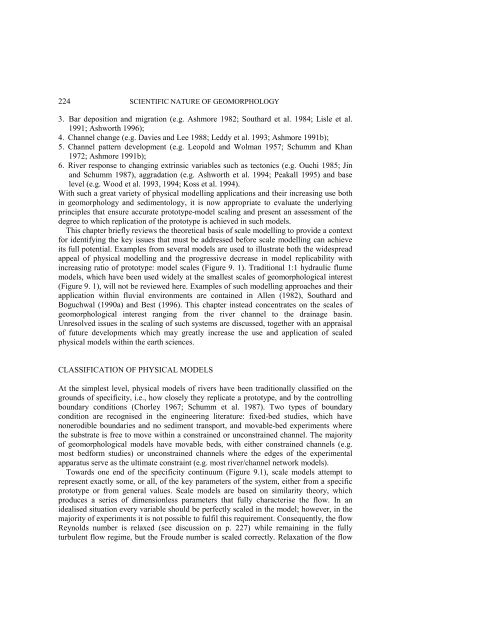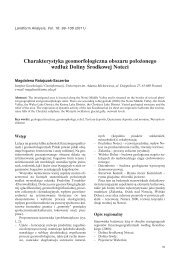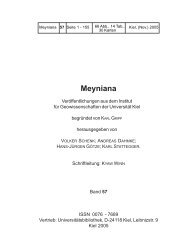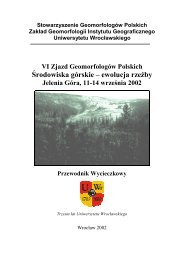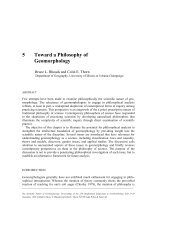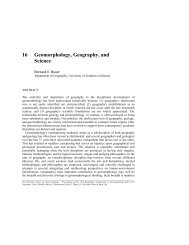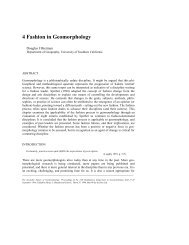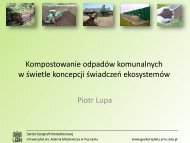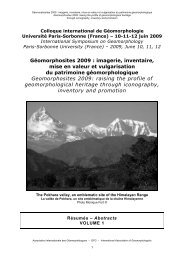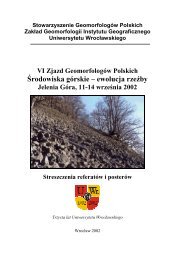Physical Modelling in Fluvial Geomorphology
Physical Modelling in Fluvial Geomorphology
Physical Modelling in Fluvial Geomorphology
Create successful ePaper yourself
Turn your PDF publications into a flip-book with our unique Google optimized e-Paper software.
224 SCIENTIFIC NATURE OF GEOMORPHOLOGY<br />
3. Bar deposition and migration (e.g. Ashmore 1982; Southard et al. 1984; Lisle et al.<br />
1991; Ashworth 1996);<br />
4. Channel change (e.g. Davies and Lee 1988; Leddy et al. 1993; Ashmore 1991b);<br />
5. Channel pattern development (e.g. Leopold and Wolman 1957; Schumm and Khan<br />
1972; Ashmore 1991b);<br />
6. River response to chang<strong>in</strong>g extr<strong>in</strong>sic variables such as tectonics (e.g. Ouchi 1985; J<strong>in</strong><br />
and Schumm 1987), aggradation (e.g. Ashworth et al. 1994; Peakall 1995) and base<br />
level (e.g. Wood et al. 1993, 1994; Koss et al. 1994).<br />
With such a great variety of physical modell<strong>in</strong>g applications and their <strong>in</strong>creas<strong>in</strong>g use both<br />
<strong>in</strong> geomorphology and sedimentology, it is now appropriate to evaluate the underly<strong>in</strong>g<br />
pr<strong>in</strong>ciples that ensure accurate prototype-model scal<strong>in</strong>g and present an assessment of the<br />
degree to which replication of the prototype is achieved <strong>in</strong> such models.<br />
This chapter briefly reviews the theoretical basis of scale modell<strong>in</strong>g to provide a context<br />
for identify<strong>in</strong>g the key issues that must be addressed before scale modell<strong>in</strong>g can achieve<br />
its full potential. Examples from several models are used to illustrate both the widespread<br />
appeal of physical modell<strong>in</strong>g and the progressive decrease <strong>in</strong> model replicability with<br />
<strong>in</strong>creas<strong>in</strong>g ratio of prototype: model scales (Figure 9. 1). Traditional 1:1 hydraulic flume<br />
models, which have been used widely at the smallest scales of geomorphological <strong>in</strong>terest<br />
(Figure 9. 1), will not be reviewed here. Examples of such modell<strong>in</strong>g approaches and their<br />
application with<strong>in</strong> fluvial environments are conta<strong>in</strong>ed <strong>in</strong> Allen (1982), Southard and<br />
Boguchwal (1990a) and Best (1996). This chapter <strong>in</strong>stead concentrates on the scales of<br />
geomorphological <strong>in</strong>terest rang<strong>in</strong>g from the river channel to the dra<strong>in</strong>age bas<strong>in</strong>.<br />
Unresolved issues <strong>in</strong> the scal<strong>in</strong>g of such systems are discussed, together with an appraisal<br />
of future developments which may greatly <strong>in</strong>crease the use and application of scaled<br />
physical models with<strong>in</strong> the earth sciences.<br />
CLASSIFICATION OF PHYSICAL MODELS<br />
At the simplest level, physical models of rivers have been traditionally classified on the<br />
grounds of specificity, i.e., how closely they replicate a prototype, and by the controll<strong>in</strong>g<br />
boundary conditions (Chorley 1967; Schumm et al. 1987). Two types of boundary<br />
condition are recognised <strong>in</strong> the eng<strong>in</strong>eer<strong>in</strong>g literature: fixed-bed studies, which have<br />
nonerodible boundaries and no sediment transport, and movable-bed experiments where<br />
the substrate is free to move with<strong>in</strong> a constra<strong>in</strong>ed or unconstra<strong>in</strong>ed channel. The majority<br />
of geomorphological models have movable beds, with either constra<strong>in</strong>ed channels (e.g.<br />
most bedform studies) or unconstra<strong>in</strong>ed channels where the edges of the experimental<br />
apparatus serve as the ultimate constra<strong>in</strong>t (e.g. most river/channel network models).<br />
Towards one end of the specificity cont<strong>in</strong>uum (Figure 9.1), scale models attempt to<br />
represent exactly some, or all, of the key parameters of the system, either from a specific<br />
prototype or from general values. Scale models are based on similarity theory, which<br />
produces a series of dimensionless parameters that fully characterise the flow. In an<br />
idealised situation every variable should be perfectly scaled <strong>in</strong> the model; however, <strong>in</strong> the<br />
majority of experiments it is not possible to fulfil this requirement. Consequently, the flow<br />
Reynolds number is relaxed (see discussion on p. 227) while rema<strong>in</strong><strong>in</strong>g <strong>in</strong> the fully<br />
turbulent flow regime, but the Froude number is scaled correctly. Relaxation of the flow


